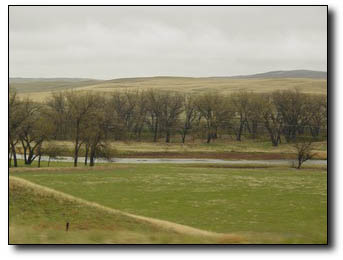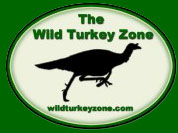|

Hunting
Merriam's Turkeys on the Nebraska Plains
By T.R. Michels, Trinity Mountain
Outdoors
 |
|
Nebraska Sandhills
|
The sun was already high in the sky
when Bill and I saw our first Nebraska turkeys. They
weren't in the wooded ravines where I expected them;
they were just off the highway that ran through the
Sandhills Region of north central Nebraska. I had
just commented on the lack of trees, except for those
around the numerous abandoned and occasionally occupied
farmhouses. Then I saw the two tom turkeys, strutting
20 yards from a highway department sand pile, 50 yards
from a farmhouse, complete with a dog lying in the
dust near the front porch and several cats. Because
of the amount of white on their tail feathers and
rump I thought they were domestic turkeys. But, when
we passed a flock of fifteen turkeys walking across
the prairies 15 miles down the road I realized I was
seeing my first Merriam's Turkeys.
I couldn't understand what the birds
were doing on the open prairie until a few days later,
after I had been hunting. Because of the limited habitat
available to the big birds in Nebraska, turkeys have
learned to adapt to their environment. On the Great
Plains the forested areas usually associated with
turkeys and turkey habitat occur mainly along the
major rivers and their tributaries. In general, the
only areas with trees large enough for turkeys to
roost in are along the rivers or near the widely scattered
farmsteads and small towns. Several farms and towns
in this area have their own resident flock of turkeys.
I'd chosen this area to hunt because
a map provided to me by the National Wild Turkey Federation
showed that one of the highest concentrations of Merriam's,
and Merriam's/Eastern hybrid turkeys in North America
occurs along the Niobrara River near the town of Valentine,
Nebraska. This area is primarily wooded bluffs and
river bottoms. West of Valentine you are likely to
see more pine forest than hardwoods. The change doesn't
seem to bother the turkeys however, because we found
birds in both types of forest. On top of the bluffs,
away from the river, the surroundings change to the
endless rolling plains of grass common to the Dakotas
and Nebraska, which is more suited to sharp-tails,
prairie chickens, long billed curlews and coyotes
than to turkeys. Water is limited and trees are scarce
on the prairies, which explains why the turkeys I
saw earlier were near the farms.
Turkeys prefer to roost in trees where
possible, and the groves around the farms may offer
the only trees for miles around. The farm sites also
offer feed in the form of grain for the cattle and
insects associated with cattle droppings. The overflow
from stock tanks and the stock ponds on the farms
provide needed water for the birds. Since many of
the local people don't hunt, the turkeys move right
in and become semi-tame. Many of the farmers and their
wives look upon these birds as pets, and don't allow
hunting. Even if they did, trying to get within range
of these "yard bird " turkeys on the open
prairie is next to impossible. There is just no place
to set up. Hunting their "country cousins"
along the river bottoms, however, is much like hunting
turkeys anywhere else. After obtaining permission
to hunt on a 12,000 acre ranch we began scouting along
the tops of the bluffs adjacent to the river, where
we could four wheel drive from one ravine to the next
along five miles of the river.
In open country I prefer to locate
birds by calling from the top of a ridge that falls
into a ravine or valley on one or more sides, so I
can hear any answering calls from as many directions
as possible. I use a crow call or owl hooter to try
to get the birds to "shock gobble' in response
to my calling. If I don't get an answer I wait five
to ten minutes and try again. If I still don't get
an answer I drive to the next ridge and continue until
I get a bird to answer. When I use turkey calls in
wide open country I use a high pitched mouth diaphragm,
or one of the new aluminum striker calls, because
the high pitched sounds of these calls carry farther
than other calls. Recent turkey research shows that
the calls of Merriam's, Rio Grande and Gould turkeys
are higher pitched than the calls of their eastern
counterparts. When I am calling I like to sound as
much like the local birds as possible, and can do
this with the new aluminum calls.
When you hear a bird in this country
you have to realize that sound carries a long way.
I have had birds respond, and heard them, from as
far away as a mile and a half. You also have to realize
that calls echo off the bare canyon walls in this
country; one lone tom may sound like a whole flock.
On more than one occasion I have gone to look for
a flock of toms I though was in the next ravine, only
to find out that it was one bird, and it was two or
more ravines away. When you put birds to bed at night
be sure you know the exact location of the bird before
you leave, or you may start hunting the next morning
only to find yourself in the wrong ravine.
Hunting this wide-open
country presents some problems that eastern hunters
may not be prepared for. Spring weather on the prairie
may change from blizzard conditions with temperatures
in the 30's one day, to clear skies with temperatures
reaching the upper 80's the next. You should take
along both heavy and light camouflage clothing, and
rain gear. A good pair of comfortable, lightweight
waterproof boots are a must when you walk miles across
the prairie and cross low lying boggy areas and streams
to get the birds. Because of the distances traveled
on foot I also take along a combination backpack and
folding seat to sit on.
Next
Page-->>
If you are interested in more turkey
hunting tips, or more turkey biology and behavior,
click on Trinity Mountain Outdoor News and T.R.'s
Hunting Tips at www.TRMichels.com. If you have questions
about turkeys log on to the T.R.'s Tips message board.
To find out when peak turkey gobbling can be expected
in your area, click on Peak Turkey Gobbling Dates.
This article is an excerpt from the
Turkey Addict's Manual ($14.95 + $5.00 S&H), by
T.R. Michels, available in the Trinity Mountain Outdoor
Products catalog.
T.R. Michels is a nationally recognized
game researcher/wildlife behaviorist, outdoor writer
and speaker. He is the author of the Whitetail, Elk,
Duck & Goose, and Turkey Addict's Manuals. His
latest products are the 2003 Revised Edition of the
Whitetail Addict's Manual, the 2003 Revised Edition
of the Elk Addict's Manual; and the 2003 Revised Edition
of the Duck & Goose Addict's Manual. For a catalog
of books and other hunting products contact: T.R.
Michels, Trinity Mountain Outdoors, PO Box 284, Wanamingo,
MN 55983, USA. Phone: 507-824-3296, E-mail: TRMichels@yahoo.com,
Web Site: www.TRMichels.com
|

